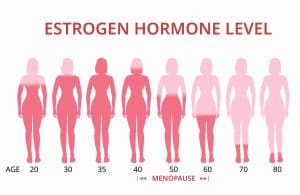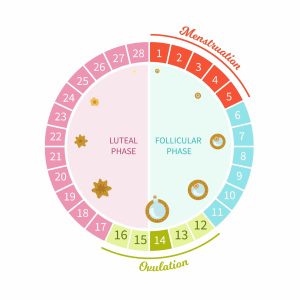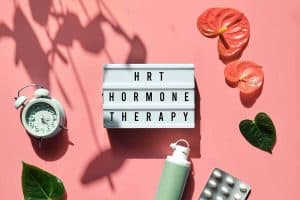Medically reviewed by Catherine Hansen, MD, OBGYN & Menopause specialist
Perimenopause and menopause are two distinct stages in a woman’s reproductive life that are often misunderstood and shrouded in mystery. This blog post aims to explain more about these two distinct life stages – exploring their differences, the hormonal changes that are happening, symptoms, and available treatments. We hope it leaves you feeling more confident about what to expect from both perimenopause and menopause – and ready to embrace these stages of life!
Short Summary
- Perimenopause and Menopause are characterized by hormonal changes that can lead to symptoms such as hot flashes, night sweats, vaginal dryness, and weight gain.
- Perimenopause refers to the time leading up to menopause – where symptoms are often experienced. Menopause itself is a one day event! The anniversary of your very last menstrual cycle.
- Treatment options include hormonal treatments such as hormone replacement therapy (HRT) [most recently approved term is menopausal hormone therapy (MHT)], non-hormone prescriptions or alternative treatments tailored to individual needs.
- Early menopause, occurring before the age of 40, is associated with increased health risks which should be addressed with a healthcare provider.
Understanding Perimenopause and Menopause
Perimenopause is the transition period leading up to menopause, characterized by hormonal changes and a wide range of symptoms, such as irregular periods, hot flashes, and mood changes. Menopause, on the other hand, is marked by the cessation of menstrual periods for twelve months, with most women entering this stage around the age of 51.
For some people, perimenopause and menopause will pass by with no major issues. But for many women, the symptoms they experience can have an impact on their mental and physical health – but support is available! By understanding the hormonal changes that occur during perimenopause and menopause, we can better identify the symptoms and manage them accordingly.
Hormonal Changes During Perimenopause
During perimenopause, declining estrogen levels are responsible for the hormonal changes that lead to menopausal symptoms. Follicle stimulating hormone (FSH) is produced by the pituitary gland and stimulates the ovaries to release an egg during ovulation. FSH levels can be measured but are not necessary to assess the onset of menopause. Assuming you are healthy and your doctor doesn’t find anything else on a full physical exam and workup, the onset of symptoms such as hot flashes, night sweats and genital and urinary symptoms indicate that perimenopause has begun.
The follicle stimulating hormone (FSH) and luteinizing hormone (LH) play a primary role in regulating estrogen levels. This control system enables the body to regulate its own hormonal balance. FSH stimulates the follicles in the ovaries to produce estrogen, which triggers the brain to cease FSH production and initiate a surge of LH when it reaches a certain level. The physical changes experienced during perimenopause are attributable to these hormonal alterations, particularly fluctuations in circulating estrogen levels. It can be helpful to think of it as a second puberty – or puberty in reverse. Our hormones are changing and fluctuating more than normal and this is what causes many of the symptoms.
As we get older, the ovaries start to produce less estrogen in anticipation of ceasing to release eggs altogether.
Hormonal Changes During Menopause
Menopause is associated with a decrease in the body’s production of estrogen and progesterone, resulting in a decrease in the body’s capacity to regulate hormones. This hormonal imbalance can manifest in various symptoms, including hot flashes, night sweats, and vaginal dryness.
Common Symptoms of Perimenopause and Menopause
Perimenopause and menopause share several common symptoms, such as hot flashes, night sweats, vaginal dryness, weight gain, and changes in metabolism. These perimenopausal and menopausal symptoms can impact a woman’s daily life and well-being, so it’s important we understand, identify, and manage them effectively. Women who enter perimenopause at an earlier age generally have a longer duration of symptoms compared to those who commence later, according to a study run on multiethnic women across the Nation.
It’s worth noting that, while similar, each woman’s experience with perimenopause and menopause is unique, and symptoms may vary in intensity and duration. By staying informed and proactive, women can better navigate these life stages and make necessary adjustments to maintain their overall health and well-being.
Hot Flashes and Night Sweats
Hot flashes and night sweats are common symptoms of perimenopause and menopause, affecting many women during these life stages. A hot flash is a sudden sensation of warmth that may be accompanied by perspiration and a red, flushed face, while night sweats are similar but occur at night, resulting in drenching sweats.
The exact cause of hot flashes remains unknown, but estrogen is believed to play a role. Hot flashes vary in intensity and duration, ranging from a fleeting sense of warmth to a sensation of being engulfed by fire “from the inside out”. They may continue for nearly a decade around the time of menopause, although the intensity of the symptoms tends to decrease after approximately two years.
Vaginal Dryness and Sexual Health
Vaginal dryness is a common symptom of perimenopause and menopause, which can sometimes lead to discomfort during sexual intercourse and potentially impact sexual desire. Like many of the other symptoms associated with perimenopause, vaginal dryness is likely attributed to a decrease in estrogen levels.
Addressing vaginal dryness and other sexual health matters is super important during perimenopause and menopause – sex plays a huge part of our emotional and physical well-being! Using vaginal lubricants and ensuring heightened levels of arousal can help alleviate dryness, and consulting a professional doctor or healthcare provider if experiencing a decreased libido can provide guidance on addressing the issue.
Weight Gain and Metabolism Changes
Weight gain during perimenopause is not uncommon and is often associated with the change in our reproductive hormones, which can influence metabolism and result in weight gain. Observing a nutritious diet, engaging in regular physical activity, and ensuring adequate sleep may assist in avoiding weight gain during perimenopause. By maintaining a healthy lifestyle, women can better manage the physical changes and challenges associated with perimenopause and menopause – as well as support their mental health during this time.
Diagnosing and Identifying Perimenopause and Menopause
Diagnosing perimenopause and menopause is vital for determining the appropriate treatment options and managing symptoms effectively. The process typically involves tracking menstrual cycle patterns and other symptoms.
While it is not obligatory to consult a healthcare provider for a perimenopause diagnosis, doing so can provide valuable insight and guidance for managing symptoms and maintaining optimal health during this life stage.
Menstrual Cycle Patterns
Monitoring menstrual cycle patterns is an aspect taken into account when diagnosing perimenopause and menopause. Although tracking the period cycle is a popular practice for fertility, it can be helpful when getting to perimenopause and menopause too. Know that during menopause periods get whacky and a bit unpredictable. No need to be concerned about it, it’s just part of our nature! But this is why it is important to use birth control if you are sexually active until menopause is reached because missed periods do not mean you have stopped being fertile yet. Menopause arrives once you miss 12 consecutive periods.
Apps like MyFlow, among many others, help you to keep track of your cycle. If you rather keep track of it on paper, we recommend you to search for one of the many menstrual cycle tracking charts available on the internet. Try to keep a note of times your period is late, your cycle is longer, or you miss a period altogether. If you track things like your Basal Body Temperature you can also confirm whether or not you’re ovulating.
Hormone Testing
Hormone testing is another component of diagnosing perimenopause and menopause but not necessary. Hormone testing involves the assessment of hormone levels in the body, such as FSH, estradiol, luteinizing hormone (LH), and thyroid-stimulating hormone (TSH). This testing helps rule out other causes of symptoms, identify and track hormone-related conditions, determine the underlying causes of symptoms, and assist in making treatment decisions.
Hormone testing is typically conducted via a blood test, with the sample forwarded to a laboratory for evaluation.
Treatment Options for Menopause and Perimenopause Symptoms
Various treatment options are available for managing perimenopause and menopause symptoms, including hormone replacement therapy (HRT) or menopausal hormone therapy (MHT), and alternative treatments. These treatments aim to alleviate symptoms and improve the overall quality of life for women experiencing perimenopause and menopause.
Understanding the available treatment options and their potential benefits and risks is essential for making informed decisions about your health during these life stages. By working with healthcare providers and exploring different treatment options, women can find the best approach to manage their symptoms and maintain their well-being.
Hormone Replacement Therapy (HRT)
Hormone replacement therapy (HRT) or menopausal hormone therapy is a medical treatment utilized to alleviate symptoms of menopause by supplementing the female hormones that are no longer produced or are naturally declining during menopause. This therapy involves administering hormones to substitute the ones that the body ceases to produce during menopause, providing relief from various menopausal symptoms.
While HRT remains the most effective treatment for most perimenopausal symptoms, it may also lead to certain conditions. It is crucial for women to discuss their symptoms and concerns with their healthcare providers to determine if HRT is the most suitable option for them.
Alternative Treatments
Whether you are taking HRT or not, a balanced lifestyle can help you manage your symptoms and have a happier, healthier menopause. Lifestyle modifications such as exercise and a nutritious diet and mind-body interventions like relaxation and cognitive behavioral therapy are shown to help ease perimenopause and menopause symptoms and overall life quality.
In addition, alternative treatments for perimenopause and menopause symptoms include herbal supplements like black cohosh and ginseng, and acupuncture. Nevertheless, there is not enough scientific data to show how efficient these treatments are for perimenopause and menopause symptoms.
By exploring various alternative treatments, women can find the best approach for managing their symptoms and maintaining a healthy lifestyle during perimenopause and menopause. It is essential to consult with a doctor and consider individual needs and preferences when selecting the most suitable treatment options.
Early Menopause and Associated Risks
Early menopause, also known as premature menopause, occurs in women aged 40 or younger. This can be due to medical conditions, surgical procedures, or other factors, and is associated with increased health risks and complications.
Understanding the causes of early menopause and the associated health risks is essential for women who experience this condition, as it allows them to make informed decisions about their health and well-being during this life stage.
Causes of Early Menopause
Early menopause may be attributed to various factors, including genetics, autoimmune disorders, infections, and medical treatments such as chemotherapy, radiation, or surgery.
Health Risks and Complications
Early menopause is associated with heightened health risks and complications, such as an increased risk of cardiovascular disease and osteoporosis. Women who experience early menopause should work closely with their healthcare providers to address these risks and implement strategies to maintain their overall health and well-being.
Preventative Health Care
As part of all the above, preventative healthcare is essential for midlife women to maintain overall well-being. In addition to perimenopause and menopause treatments, a comprehensive approach includes nutrition, exercise, sleep, stress management, and regular screenings. A balanced diet with fruits, vegetables, whole grains, and lean proteins supports health, while supplements like calcium and vitamin D aid bone health.
Regular exercise improves cardiovascular fitness, bone density, and mental well-being. Adequate sleep and stress management techniques are crucial for hormonal balance and reducing stress levels. Regular screenings and check-ups through conventional medicine, such as blood pressure monitoring and mammograms, detect potential health issues early on. It’s important to know your screenings timeline and have them done in time. We know as women we are always very busy and it is easy to forget about our care, but it’s never too late to start doing it! We encourage you to prioritize your health and work with healthcare professionals to develop personalized preventative care plans. A great resource we recommend you check out is the Office Of Women’s Health for great healthy living tips!
Takeaway
In conclusion, perimenopause and menopause are natural life stages that affect every woman differently. By understanding the hormonal changes, symptoms, and available treatments, women can take control of their health and navigate these transitions with confidence and without fear. Whether experiencing perimenopause, menopause, or early menopause, staying informed, proactive, and working with expert doctors is key to maintaining overall well-being and embracing the journey ahead.
Disclaimer: This article is for general informational purposes and is NOT a substitute for professional medical advice. Always seek the advice of your healthcare provider before starting or changing acne treatment.







